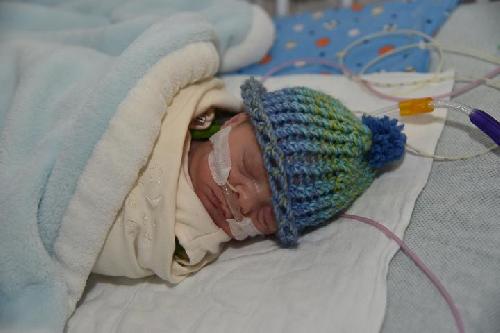An imbalance of certain gut microbes appears to be the underlying cause of a frequently fatal intestinal illness in premature babies, according to new research led by Washington University School of Medicine in St. Louis.
Analyzing gut bacteria in premature infants, the study shows that babies who developed necrotizing enterocolitis had a different mix of microbes in their intestines than babies who never developed the condition. The diverging microbial communities were observed before any evidence of disease, suggesting it may be possible to prevent the illness by keeping the balance of gut microbes in check.
The study appears online March 8 in The Lancet.
 An imbalance of certain gut microbes appears to be the underlying cause of a frequently fatal intestinal illness in premature babies, according to new research led by Washington University School of Medicine in St. Louis. Credit: Robert Boston
An imbalance of certain gut microbes appears to be the underlying cause of a frequently fatal intestinal illness in premature babies, according to new research led by Washington University School of Medicine in St. Louis. Credit: Robert Boston
"Premature infants who survive the first two weeks of life have a much higher risk of dying of necrotizing enterocolitis than of anything else," said corresponding author Phillip I. Tarr, MD, the Melvin E. Carnahan Professor of Pediatrics. "We're pleased that our work now identifies classes of bacteria on which to focus future investigations of treatment and prevention strategies. We would like this study to open discussions about what the next steps should be to protect premature infants from this destructive disease."
The researchers showed, in general, that babies who developed necrotizing enterocolitis had higher proportions of Gram-negative bacteria and lower proportions of strictly anaerobic bacteria -- those that live without oxygen -- in their guts compared with babies who didn't develop the disease.
The Gram-negative bacteria implicated in the study are classified as Gammaproteobacteria and include organisms well-known for causing serious infections and driving inflammation, such as Escherichia coli (E. coli), Klebsiella and Enterobacter. The study also suggested that having more anaerobic bacteria in the gut protects against necrotizing enterocolitis. Such organisms included classes of bacteria called Clostridia and Negativicutes, which might possess anti-inflammatory capabilities.
Conflicting data from past studies have made it difficult to pin down factors that might lead to necrotizing enterocolitis, a leading cause of death among premature infants born throughout the world. Because of this lack of clarity, death rates in premature babies that develop the disease remain at about 30 percent, essentially unchanged over the past 30 years.
The researchers analyzed data from almost 1,000 premature infants cared for in the neonatal intensive care units at St. Louis Children's Hospital, part of Washington University Medical Center; Children's Hospital at Oklahoma University Medical Center; and Kosair Children's Hospital in Louisville, Ky. Washington University collaborators included Elena Deych, research statistician, and William D. Shannon, PhD, professor of biostatistics in medicine, and investigators at The McDonnell Genome Institute.
About 6 percent of the infants in the study developed the disease. Of those with the condition, 36 percent died. In the 94 percent who did not get necrotizing enterocolitis and served as the control group, two babies, about 1.7 percent, died from other causes.
"The holy grail for necrotizing enterocolitis is prevention," said first author Barbara B. Warner, MD, professor of pediatrics. "Despite aggressive treatment with antibiotics and surgery, infants who develop the most severe form of necrotizing enterocolitis die within hours."
Warner described the disease progression as an inflammatory process that starts on the inside of the gut and results in tissue death. Some babies respond to antibiotics, but many need surgery to remove dead tissue. When treatment fails, death is caused by septic shock, an overwhelming inflammatory response to infection.
The new study differs from past efforts to investigate necrotizing enterocolitis because of its large sample size and thorough DNA sequencing strategy that involved collecting and analyzing thousands of babies' stools. This allowed the investigators to monitor the fast-changing gut microbial communities typical of babies in the first weeks of life and to gather these data before disease developed.
Importantly, the researchers noted that differences in the microbial content of the gut were most apparent in the most premature babies, those born before 27 weeks' gestation. These very premature babies also are at higher risk of the disease than babies born after 27 weeks. In addition, the makeup of gut microbe communities in babies that developed the disease did not diverge from the others until at least one month of life. While the condition can develop at any time during the first two months of life, it often doesn't occur until after the first month, especially in the most premature babies.
Such data suggest there is a window for identifying infants at highest risk of developing the disease -- at about one month after birth, when bacterial differences emerge but before symptoms are apparent.
The investigators pointed out that babies receiving their mother's breast milk have a lower risk of developing necrotizing enterocolitis. But even so, concerted efforts to provide breast milk have not driven down rates of the condition.
Now, Warner and Tarr are focusing on possible ways to prevent or reverse the microbial imbalance they identified, so as to avert the development of necrotizing enterocolitis.
"Antibiotics delivered to the bloodstream tend not to penetrate into the gut," Warner said. "So the route of administration may make a difference. Past efforts to give antibiotics directly into the gut were stopped because of concerns about bacteria developing resistance, but also because of possible safety and toxicity issues for the baby.
"Since then, we've learned a lot about how a premature baby's body processes these antibiotics, so future studies would be designed with these concerns in mind," she added. "Our first rule is 'Do no harm.' For prevention studies in particular, safety is extremely important because we will be treating premature infants who potentially won't get the disease."
source: Washington University School of Medicine